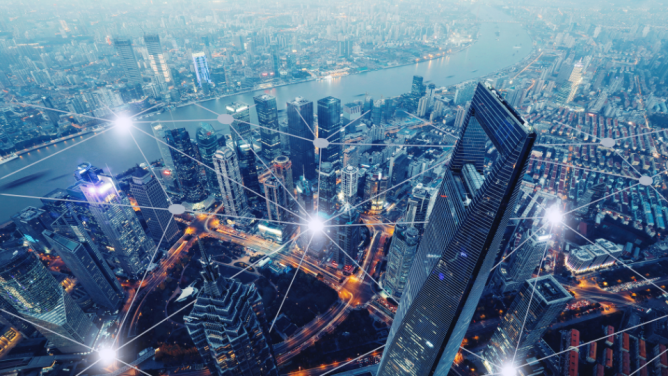Fresh water a rare commodity?
For people living in regions with very good access to quality water resources and infrastructure – i.e. where you simply turn on a tap to get drinking water – it is difficult to comprehend how water stress affects many on a global scale. In reality, only 2.5% of the earth’s water is “fresh”. Only a tiny portion of the earth’s water is fit for consumption, and by showing water distribution in the form of a diagram, it helps us understand the order of magnitude. At the same time, access to clean water is becoming increasingly difficult for a growing part of the world’s population: 2.2 billion people do not have access to drinking water and more than half of the world’s population have temporary access restrictions. Cities are particularly affected, feeling at choking point as urban planning policies are failing to keep up with the pace of urbanization. The number of city inhabitants lacking safely managed drinking water has increased by 50% since 2000.
Multifactorial stress
This increasing pressure results from a combination of factors. The first is societal: a change in our consumption behavior coupled with strong demographic pressure has led to an acceleration in demand. According to the OECD, global demand for drinking water is expected to increase by 55% between 2000 and 2050. The second factor is related to the climate: rising temperatures and ecosystem degradation limit the availability of fresh water. Droughts, melting glaciers and rising sea levels which lead to the salinization of coastal groundwater all affect the water supply of a sixth of the world’s population! The environmental factor is reflected in an increase in water quality degradation, as 25% of Europe’s surface waters are chemically polluted. The economic factor can be felt too, as there is increasing competition in water needs between agriculture, industry and domestic use. Finally, the infrastructure factor also plays a major role, as leakage in obsolete water installations causes the loss of around 30% of supplied drinking water globally!
The water wars
With water being essential to human life, water scarcity makes this “blue gold” the central character of many conflicts. The Pacific Institute has put together a well-documented chronology of more than 340 water-related conflicts in the world. The recent attacks on the Kakhovka dam in Ukraine or the destruction of water wells in Gaza also remind us that even when it is not the main cause of a conflict, water remains at the heart of geopolitical and military concerns. UNESCO’s United Nations World Water Development Report 2024 reveals that 40% of the world’s population lives in transboundary lake or river basins, and that only a fifth of those countries concerned have put in place cross-border agreements to manage these shared resources.
Watertech to the rescue
New players are emerging on the scene to address water scarcity, and with it ushering in a brand new technological sector: watertech. They are tackling a market whose economic value is estimated by the WWF to be €58,000 billion, or 60% of global GDP. This colossal figure allows us to imagine the path ahead for companies which currently attract barely 3% of climate tech funding.
Some newcomers on the scene are rethinking the way we treat and purify water. Take Hydroleap, which shuns chemicals from its silty water treatment processes, replacing them with electrocatalytic treatment technology. In the same vein, NXO-engineering harnesses the power of microalgae and its potential to purify water, enabling us to imagine treatment plants of the future. Aio-Loop offers a wastewater treatment solution that requires less energy and land.
Other players are focusing on developing new water recovery systems. With its Hydropanels technology, Source is working to collect vapor in the atmosphere using hygroscopic materials. Meanwhile Oneka aims to create a wave-powered desalination solution!
Concerning infrastructure, monitoring solutions can help better control and limit leakages. ACWA robotics sends autonomous robots into pipes to detect leaks. Meanwhile others, such as Leakmited, use AI to analyze the current state of infrastructure. WMI (Vinci Construction Grands Projets), a Water Loss Reduction provider, combines both an integral and holistic approach to achieve significant water loss reduction results under PBC – Performance-Based Contract arrangement.
Finally, circular economy players are also getting in on the action by looking at wastewater reuse options. This is the case with Hydraloop, which is developing a solution that can be implemented on any network to make it easier to reuse grey water.
Finally, in the energy sector, we might mention Geocean (VINCI Construction), with its ocean geothermal and thalassothermal solutions, or Thermiup, which develops heat recovery systems for wastewater to avoid thermal wastage.
The fair price of water
However, these effective technological solutions have a limit, as they are often expensive and raise the question of the fair price of water. As our most precious and irreplaceable resource, the solution to the latter requires innovative financing methods. The city of Dunkirk in France introduced progressive water pricing, in order to distinguish between “essential,” “useful” and “comfort” consumption. Portugal has created the “family water tariff” so that large family households are not penalized. Other countries are adopting social pricing so as to guarantee access to water for lower income households. In Bogota, a fund created by AECID provides 800,000 of the city’s most vulnerable inhabitants with access to water. Others believe that a “global water market” – similar to the practice of carbon credits – could help regulate its use by encouraging good practices.
Water and common goods: the limits of a technological approach
Often described as a “common good,” water is a resource with a rather special status. As such, there is a political dimension behind how it is collected, treated and distributed. The Global Commission on the Economics of Water has called for a global pact to resolve the water crisis, proposing a seven-point action plan which includes better collaboration between the public, private and civil spheres concerning the right to water, bringing an end to the underpricing of water, and publishing the “water footprints” of the most water-consuming sectors.
Technically relatively archaic and eminently politically complex, the water sector must now reinvent itself to avoid a global collapse. To achieve this, it must mobilize the capacity for innovation driven by “watertechs” while reflecting on the unique status of water resources.

